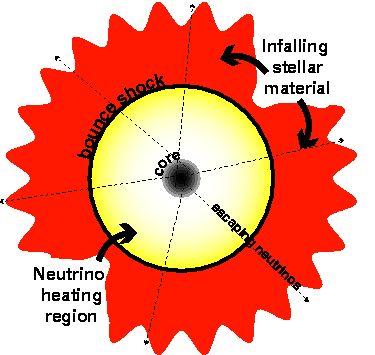
Do neutrinos drive the explosions of massive stars? One current idea is that this happens via the medium of plasma waves, but Stephen Hardy and Don Melrose have now demonstrated that this is not possible.
At the end of its life a massive star becomes a supernova, releasing huge amounts of energy in a dazzling explosion. Paradoxically, while the outer part of the star explodes the innermost core collapses under its own gravity, and it is the energy released during core collapse which powers the explosion. But the means by which energy is transferred between implosion and explosion is not fully understood. Detailed models of these processes typically fail to generate any explosion at all! One currently popular idea is that these models are failing to account properly for the role of neutrinos.
Neutrinos are massless, electrically neutral particles which interact only very weakly with other particles -- for example a neutrino incident on the Earth would very likely pass directly through it without being absorbed or scattered in any way. Nevertheless a large fraction of the power of a supernova is known to be carried by neutrinos, so their role in the explosion dynamics may be crucial. Stephen Hardy and Don Melrose have pursued this line of thought, concentrating on the idea that the neutrinos interact with the stellar envelope by emitting plasma waves -- ``Langmuir waves''. It was hoped that this would be the channel through which the neutrino power could be dumped into the outer layers of the star, with Langmuir waves being emitted by neutrinos and absorbed by the plasma. However, Stephen's calculations show convincingly that this process is not efficient enough to explain the dynamics of the explosion. Stephen is now applying similar theoretical techniques to neutrino interactions in other astrophysical contexts.
A sketch of the geometry of the collapse of a massive star. Neutrinos generated in the core are thought to interact with the plasma behind the bounce shock in order to drive the bounce shock further outwards.
